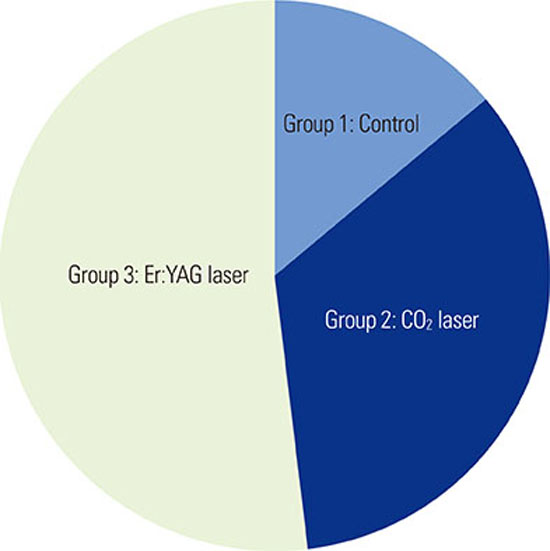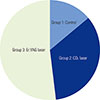1. Petersson LG. The role of fluoride in the preventive management of dentin hypersensitivity and root caries. Clin Oral Investig. 2013; 17:Suppl 1. S63–S71.

2. Tonguc MO, Ozat Y, Sert T, Sonmez Y, Kirzioglu FY. Tooth sensitivity in fluorotic teeth. Eur J Dent. 2011; 5:273–280.

3. Barbour ME, Rees GD. The role of erosion, abrasion and attrition in tooth wear. J Clin Dent. 2006; 17:88–93.
4. Lee BS, Chang CW, Chen WP, Lan WH, Lin CP. In vitro study of dentin hypersensitivity treated by Nd:YAP laser and bioglass. Dent Mater. 2005; 21:511–519.

5. Markowitz K, Pashley DH. Discovering new treatments for sensitive teeth: the long path from biology to therapy. J Oral Rehabil. 2008; 35:300–315.

6. Brannstrom M, Astrom A. The hydrodynamics of the dentine; its possible relationship to dentinal pain. Int Dent J. 1972; 22:219–227.
7. Arrais CA, Micheloni CD, Giannini M, Chan DC. Occluding effect of dentifrices on dentinal tubules. J Dent. 2003; 31:577–584.

8. Pashley DH, Galloway SE. The effects of oxalate treatment on the smear layer of ground surfaces of human dentine. Arch Oral Biol. 1985; 30:731–737.

9. Kerns DG, Scheidt MJ, Pashley DH, Horner JA, Strong SL, Van Dyke TE. Dentinal tubule occlusion and root hypersensitivity. J Periodontol. 1991; 62:421–428.

10. Jacobsen PL, Bruce G. Clinical dentin hypersensitivity: understanding the causes and prescribing a treatment. J Contemp Dent Pract. 2001; 2:1–12.

11. Matsumoto K, Funai H, Shirasuka T, Wakabayashi H. Effects of Nd: YAG- laser in treatment of cervical hypersensitive dentine. Jpn J Conserv Dent. 1985; 28:760–765.
12. Rohanizadeh R, LeGeros RZ, Fan D, Jean A, Daculsi G. Ultrastructural properties of laser-irradiated and heat-treated dentin. J Dent Res. 1999; 78:1829–1835.

13. Zhang C, Matsumoto K, Kimura Y, Harashima T, Takeda FH, Zhou H. Effects of CO2 laser in treatment of cervical dentinal hypersensitivity. J Endod. 1998; 24:595–597.

14. Aranha AC, Domingues FB, Franco VO, Gutknecht N, Eduardo Cde P. Effects of Er:YAG and Nd:YAG lasers on dentin permeability in root surfaces: a preliminary in vitro study. Photomed Laser Surg. 2005; 23:504–508.
15. Kimura Y, Wilder-Smith P, Yonaga K, Matsumoto K. Treatment of dentine hypersensitivity by lasers: a review. J Clin Periodontol. 2000; 27:715–721.

16. Kantorowitz Z, Featherstone JD, Fried D. Caries prevention by CO2 laser treatment: dependency on the number of pulses used. J Am Dent Assoc. 1998; 129:585–591.

17. Ten Cate AR. Composition formation and structure of dentin. In : Nanci A, Ten Cate AR, editors. Ten Cate's oral histology: development, structure, and function. 7th ed. St. Louis: Mosby Elsevier;2008. p. 166–168.
18. Ari H, Erdemir A. Effects of endodontic irrigation solutions on mineral content of root canal dentin using ICP-AES technique. J Endod. 2005; 31:187–189.

19. Pulido MT, Wefel JS, Hernandez MM, Denehy GE, Guzman-Armstrong S, Chalmers JM, et al. The inhibitory effect of MI paste, fluoride and a combination of both on the progression of artificial caries-like lesions in enamel. Oper Dent. 2008; 33:550–555.

20. Wiesmann HP, Tkotz T, Joos U, Zierold K, Stratmann U, Szuwart T, et al. Magnesium in newly formed dentin mineral of rat incisor. J Bone Miner Res. 1997; 12:380–383.

21. Deutsch AS, Cohen BI, Musikant BL. Inductively coupled plasma-emission spectroscopy and atomic absorption for the use of elemental analysis of a root canal after lasing with a holmium:YAG laser. J Endod. 2003; 29:404–406.

22. Secilmis A, Altintas S, Usumez A, Berk G. Evaluation of mineral content of dentin prepared by erbium, chromium:yttrium scandium gallium garnet laser. Lasers Med Sci. 2008; 23:421–425.

23. Khabbaz MG, Makropoulou MI, Serafetinides AA, Papadopoulos D, Papagiakoumou E. Q-switched versus free-running Er:YAG laser efficacy on the root canal walls of human teeth: a SEM study. J Endod. 2004; 30:585–588.

24. Hamachi T, Iwamoto Y, Hirofuji T, Kabashima H, Maeda K. Clinical evaluation of GaAlAs-semicondoctor laser in the treatment of cervical hypersensitivity dentin. Jpn J Conserv Dent. 1992; 35:12–17.
25. Absi EG, Addy M, Adams D. Dentine hypersensitivity. A study of the patency of dentinal tubules in sensitive and non-sensitive cervical dentine. J Clin Periodontol. 1987; 14:280–284.

26. Schwarz F, Arweiler N, Georg T, Reich E. Desensitizing effects of an Er:YAG laser on hypersensitive dentine. J Clin Periodontol. 2002; 29:211–215.

27. Lan WH, Lee BS, Liu HC, Lin CP. Morphologic study of Nd:YAG laser usage in treatment of dentinal hypersensitivity. J Endod. 2004; 30:131–134.

28. Bonin P, Boivin R, Poulard J. Dentinal permeability of the dog canine after exposure of a cervical cavity to the beam of a CO2 laser. J Endod. 1991; 17:116–118.

29. Moritz A, Gutknecht N, Schoop U, Wernisch J, Lampert F, Sperr W. Effects of CO2 laser irradiation on treatment of hypersensitive dental necks: results of an in vitro study. J Clin Laser Med Surg. 1995; 13:397–400.

30. Moritz A, Gutknecht N, Schoop U, Goharkhay K, Ebrahim D, Wernisch J, et al. The advantage of CO2-treated dental necks, in comparison with a standard method: results of an in vivo study. J Clin Laser Med Surg. 1996; 14:27–32.

31. Aoki A, Ando Y, Watanabe H, Ishikawa I. In vitro studies on laser scaling of subgingival calculus with an erbium:YAG laser. J Periodontol. 1994; 65:1097–1106.

32. Walsh JT Jr, Flotte TJ, Deutsch TF. Er:YAG laser ablation of tissue: effect of pulse duration and tissue type on thermal damage. Lasers Surg Med. 1989; 9:314–326.

33. Matsui S, Kozuka M, Takayama J, Ueda K, Nakamura H, Ito K, et al. Stimulatory Effects of CO(2) Laser, Er:YAG Laser and Ga-Al-As Laser on Exposed Dentinal Tubule Orifices. J Clin Biochem Nutr. 2008; 42:138–143.

34. Takeda FH, Harashima T, Kimura Y, Matsumoto K. A comparative study of the removal of smear layer by three endodontic irrigants and two types of laser. Int Endod J. 1999; 32:32–39.

35. Rösing CK, Fiorini T, Liberman DN, Cavagni J. Dentine hypersensitivity: analysis of self-care products. Braz Oral Res. 2009; 23:Suppl 1. 56–63.

36. Dilber E, Malkoc MA, Ozturk AN, Ozturk F. Effect of various laser irradiations on the mineral content of dentin. Eur J Dent. 2013; 7:74–80.
37. Kashima-Tanaka M, Tsujimoto Y, Kawamoto K, Senda N, Ito K, Yamazaki M. Generation of free radicals and/or active oxygen by light or laser irradiation of hydrogen peroxide or sodium hypochlorite. J Endod. 2003; 29:141–143.

38. Lee BS, Lin CP, Hung YL, Lan WH. Structural changes of Er:YAG laser-irradiated human dentin. Photomed Laser Surg. 2004; 22:330–334.





 PDF
PDF ePub
ePub Citation
Citation Print
Print










 XML Download
XML Download